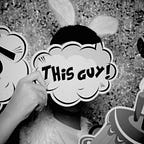Ink Experiments
Looking at ink and fluidity as an expressive stress reliever
This was originally a part of this post on my Substack. I’m moving entirely to Medium, so…
Over Thanksgiving break, I decided to spend some time with art. It was a stress relief tactic after school being a stress the weeks prior.
I don’t like traditional forms of art. I’m more into abstract, geometric, and even just weird pieces. Something with a multitude of perspectives and opinions to it.
During my two-day process, I was able to make some really cool art, and give it a spin with editing with RAW.
Playin’ with Paints
From the get-go, I wanted to make something unique and abstract. I came across this video from two years, from Art Insider:
The video shows Artist Callen Schaub with a custom trapeze, creating awesome pieces of abstract art. Thus began my idea of basically creating a trapeze or a simple pendulum in my backyard.
But the more I thought about the logistics of it, the harder it was to do. So I turned to a different route, acrylic pouring paints.
Acrylic pouring paints are great. You just get a cup, pour some paints with different patterns and styles, then pour onto canvas. Here’s a video of the methods I used:
Being my first time, I didn’t really want to splurge on expensive pouring paints and canvas, so I purchased some of the cheaper and smaller amounts. And it worked out really well. Here are a few I made:
To be totally honest, these don’t look as good digitally as they do in-person, but there’s a way to make these look amazing. And that has to do with RAW.
Editing RAW
First, what is RAW? A quick Google search gives the following:
A camera raw image file contains minimally processed data from the image sensor of either a digital camera, a motion picture film scanner, or other image scanner.
Shooting RAW ensures you are capturing as many colors in an image as possible, creating photos with a higher color range and color depth.
RAW essentially gives more room for editing and manipulation of image data. What’s even better is ProRAW, Apple’s new, proprietary RAW standard. I’ve been daily-driving iOS 14 Betas since WWDC, so I was able to test out ProRAW, which should go public soon if it already hasn’t.
Here’s a brief description of ProRAW:
ProRAW gives you all the standard RAW information, along with the Apple image pipeline data. So you can get a head start on editing, with noise reduction and multiframe exposure adjustments already in place — and have more time to tweak color and white balance.
That’s a lot of technical mumbo-jumbo. But in a nutshell, it’s RAW, but with more even data from your camera. It also takes care of a bit of the adjustment too. From testing, ProRAW photos tend to be around 20–25 MB each, so storage is a big deal.
So the day after making all the paintings, I sat down and used my iPhone, shooting in ProRAW, to take different close-ups and angles of my pictures.
Then, I imported them into Adobe Lightroom, to see what I could do. And it turns out, I had lots of freedom. Freedom to the extent whereas the new pictures don’t look anything like the original paintings, but even better.
I messed with tone curves, exposure, noise reduction, and even color profiles. For someone who hasn’t really dived into photo-editing, I was really amazed at how much freedom and flexibility I had.
After I played with adjustments for each painting, I finally was able to get the final results I wanted.
The Final Results
And here they are.
Now, these aren’t all the same as the paintings I showed above, but they are different angles and magnifications.
They look completely different and very unique, all thanks to the editing processes of RAW and Lightroom combined.
If you want to download these for use of your wallpapers or any private projects, feel free to. If you want to use them for any commercial projects, please reach out. They are in their full resolution, so the file is sort of big, and aren’t indicative of the original ProRAW files.
